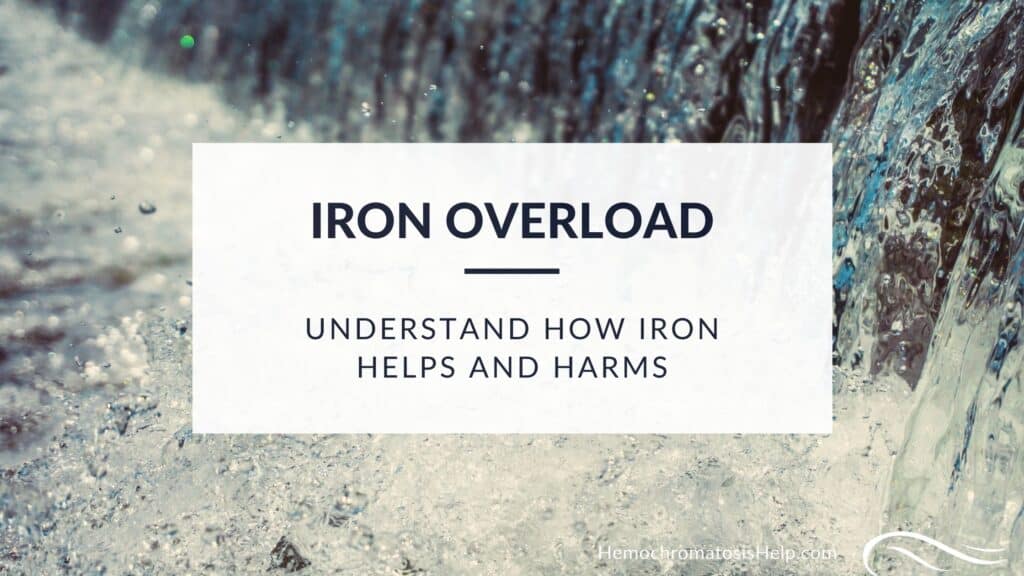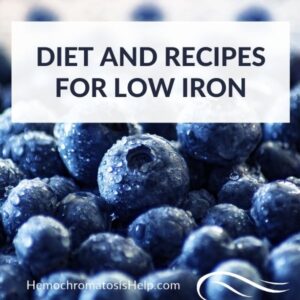Table of Contents
Introduction: The Story of Iron Overload
Ecosystems, on both small and large scales, naturally seek out balance to maintain their health and harmony.
When one element within the system is out of balance, other elements adjust to compensate and restore the system’s health.
Iron overload runs counter to the fundamental principle of balance in the body.
Human iron metabolism is supposed to be a beautiful symphony orchestra of events. Like most metabolic functions in the body, iron strives for balance: not too little, not too much.
Our bodies have a wonderful array of mechanisms that normally regulate how much iron we have in our bloodstream, in our cells, and stored away for future use.
When we require more iron, we increase iron absorption from our foods, and we increase the affinity of certain binding proteins so we can more efficiently use the iron we have.
When we have too much iron, our digestive system gets very picky about how much iron it lets into our circulation.
In this complex, yet delicate, feedback loop, one important consideration is that our bodies do not normally have a way to excrete iron.
Healthy metabolic systems prevent excess iron by reducing iron absorption, rather than increasing iron excretion.
However, unlike normally functioning systems, iron metabolism is broken in iron overload, sometimes mildly and sometimes severely.
Balance is, therefore, essential for our return to health.
Why Our Bodies Need Iron
Although this website is dedicated to the health challenges and consequences of too much iron as seen in hereditary hemochromatosis and iron overload, it is important first to understand why we might want iron in our bodies in the first place.
As a component of hemoglobin, iron helps us build red blood cells and transport oxygen and nutrients to the cells.
Balanced levels of iron help our bodies make energy and sustain life.
Without iron, our cells would starve, and we couldn’t make the energy necessary to live.
Considering the basic mechanism for cells, organs, and systems of the body to create energy depends on iron and the proteins that bind iron, it’s a critical component of health.
How Does The Body Properly Absorb, Store, and Use Iron?
Unbound iron, especially in excess, can be toxic.
That’s why our bodies have created proteins that help bind and contain free iron and help transport iron to where it belongs.
Overall, hemoglobin and ferritin are by far the most numerous iron-binding proteins in the body. Hemoglobin plays a major role in transporting iron through the bloodstream, and ferritin plays a major role in iron’s intracellular storage.
Think of it this way:
- Hemoglobin –> Iron Storage in the Bloodstream
- Ferritin –> Iron Storage in the Cells
The remainder of iron-binding proteins play crucial metabolic roles in the body, even though the amounts of iron stored in these proteins is significantly less than in hemoglobin and ferritin:
- Transferrin
- Myoglobin
- Cytochromes
Hemoglobin
Typically, with proper iron metabolism, a person has approximately 4 to 5 total grams of iron in their bodies. This amount counts both the iron that is in active use, as well as the iron that is stored away for future needs.
Over half of all iron in the body (roughly 2.5 grams) is present in our bloodstream, bound to hemoglobin and contained within our red blood cells (RBCs).
Hemoglobin assists with the vital function of oxygen and nutrient delivery to the cells and tissues.
Demonstrating how dynamic (and how thrifty) our metabolism is, the iron contained within hemoglobin gets recycled at the end of an RBC’s life cycle.
That very same iron molecule becomes incorporated in a newly formed RBC, and the cycle continues.
Healthy new RBCs and hemoglobin levels are so important to our health that the human body has no major mechanism for excreting iron.
However, if you have iron overload from hemochromatosis, your iron levels may far exceed the amount needed for adequate hemoglobin levels.
Ferritin Levels
Approximately 2 grams of iron are bound to the protein ferritin. Following hemoglobin, ferritin levels constitute the second-highest amount of iron storage.
Ferritin assists with the vital function of the energy-generating process of the cells and tissues.
One of the health benefits of iron is directly tied to its ability to help the body’s cells make energy.
As anyone with iron deficiency anemia will tell you, fatigue is a major result of too little iron.
Ironically, one of the most common hemochromatosis symptoms is also fatigue.
Too much iron disrupts the cells’ energy-generating process, as does iron deficiency, just by a different mechanism.
While all cells contain ferritin-iron complexes, the vast majority of ferritin is present within the liver, spleen, and bone marrow.
Of these tissues, the majority of ferritin storage is located in the liver. As a result, in hemochromatosis the liver is the internal organ most at risk of damage.
Ferritin plays a vital role in our body, and it is also a good way to measure the total body burden of iron. As a result, ferritin levels are an essential part of testing in hemochromatosis.
Bound Iron vs. Free Iron
It is important to distinguish the bound iron stored within hemoglobin, ferritin, transferrin, myoglobin, and the cytochromes from the free iron in the bloodstream, cells, tissues, or organs.
Essentially, iron-binding proteins contain iron so that it cannot chemically react or have a biologic function with the body.
Free iron, on the other hand, is fully capable of chemically reacting. In excess, free iron is a “pro-oxidant” toxin.
Due to the iron overload of hemochromatosis, we have too much free iron and not enough iron-binding proteins to keep it in check.
Up to a point, an excess of iron can be contained without major consequences to our health.
This is why if the problem of hereditary hemochromatosis is identified soon enough in an individual, they have a better shot of protecting their health.
At a certain threshold, however, iron overload begins to harm us.
The result is increased oxidative stress and possible long-term damage to our cells, tissues, and organs.
This is one reason why the symptoms of hemochromatosis may take years to express themselves in an iron overload disorder. This is also why it’s so important to get proper hemochromatosis lab tests done for you and your family members.
Normal Iron Metabolism
People without hemochromatosis store approximately 4-5 grams of iron in their bodies.
They also absorb 1 milligram of iron daily from food. This number is balanced out by a loss of 1 milligram of iron daily from metabolism, sweat, and skin cell loss.
Women lose approximately 1.5 to 2 milligrams a day during their menstrual cycle (and 1 milligram on non-menstruating days). This is generally compensated for by a temporary, slight increase in iron absorption during menstruation.
In normal iron metabolic situations, therefore, the net effect is a stable iron level that does not increase over time.
Keep in mind that these numbers represent an average level of “iron-in” and “iron-out” that changes based on the requirements, environment, and a wide array of inter-related aspects of overall metabolism.
When someone needs more iron, they absorb more from their diet. When they need less, they absorb less.
In an iron disorder like hereditary hemochromatosis, this normal iron metabolism is broken.
Iron Absorption: Excess Uptake
In HFE hereditary hemochromatosis, genes controlling iron absorption in the gut are permanently changed, leading to excess iron uptake into the body.
Seemingly a small change, a single protein is made differently when the HFE gene is mutated on chromosome 6. The location of the effect of the change is, perhaps, what makes this such a significant problem.
The effect is primarily upon the cells of the digestive system called enterocytes. These enterocytes normally absorb iron in the upper part of the gut known as the duodenum.
Normally, the amount of iron absorbed is quite low, ranging from 5% to 35%, given the circumstances of health and the body’s needs for iron.
If the body’s iron needs have been met, a complex feedback system should tell the gastrointestinal system to reduce the amount of iron absorption from food and water.
However, in hemochromatosis, the feedback loop is broken because of a genetic mutation causing the continued absorption of iron. Even when the body is in a state of iron overload, the gut continues to absorb more and more iron.
Excess Iron
The process of iron overload is typically slow to develop and may not affect a person’s health until they are in their 30s, 40s, or even their 50s or 60s.
Symptoms of too much iron progressively worsen over time if the root cause (hereditary hemochromatosis) is not discovered.
This slow onset is descriptive of just how minimal this change is, at least at first. Typically, the body regulates how much iron it absorbs because, although normal levels of iron are critical for good health, excess iron is toxic.
Once we take iron into our bodies, we quickly bind it with proteins such as heme, ferritin, and transferrin so that we may put it to good use with hemoglobin to build red blood cells.
Regardless of whether we have hemochromatosis or not, the following are two of the primary ways our bodies control excess iron:
- Feedback loops to decrease iron absorption
- Iron-binding proteins
Over time, if we have iron overload, our iron uptake level slowly but steadily outpaces our body’s needs and our body’s ability to bind excess iron.
Hepcidin and Ferroportin
Excess iron absorption is the result of a broken feedback loop in hereditary hemochromatosis.
Hepcidin and ferroportin are two terms central to understanding human iron absorption and metabolism.
Hepcidin is a hormone produced by the liver in response to several factors, including iron overload and inflammation. Its effect is to block the action of ferroportin.
Ferroportin is a membrane protein that transports iron from the enterocytes into circulation.
Ferroportin’s actions are assisted by another protein that causes the body to uptake iron into the bloodstream, hephaestin.
Therefore, if hepcidin is low –> then ferroportin is high. The result is that we absorb more iron than we should –> leading to iron overload.
Not surprisingly, individuals with hereditary hemochromatosis have low levels of hepcidin.
Iron Overload: Excess Accumulation
Iron overload most commonly results from having one or two copies of the hemochromatosis gene. This HFE Gene causes an excessive accumulation of iron in the cells, tissues, and organs characteristic of the iron storage disorders.
While blood levels of iron can become elevated, our bodies work hard to try and minimize such high levels of free iron in our bloodstream. This system is very tightly regulated because iron can be a “pro-oxidant” toxin.
We produce iron-binding proteins (such as hemoglobin, ferritin, and transferrin) to temporarily “inactivate” the iron.
Additionally, we shuttle the bound/inactive iron into the cells themselves.
Even though these mechanisms temporarily minimize the potential oxidative stress of iron, they ultimately set the stage for excess accumulation in the tissues.
In fact, the primary problem with excess iron has to do with its damaging effects inside the cells.
Ultimately, too much iron promotes oxidation of the tissues and organs. This oxidative damage can lead to serious health problems.
Too Much Iron
The actual, physical amount of iron overload varies between individuals with hemochromatosis.
How much iron accumulates is multi-factorial, based primarily on factors such as genetics, age, gender, and other health conditions (such as liver disease, diabetes, digestive disorders, immune or hormonal system disorders, and inflammation or infection).
Foods high in iron may also play a major role in iron overload.
When you have the hemochromatosis gene, your iron absorption level is maximal with any food ingested, whether it contains heme or non-heme iron.
Dietary iron is found in such a wide variety of foods. It would be unreasonable to eliminate all foods that contain iron for fear of iron overload.
However, a key dietary and supplemental therapeutic approach to preventing future storage of too much iron is to try and block the absorption of iron.
Blocking iron absorption is essential because the human body has no natural way to excrete iron once it is in our system.
Over time, the result is too much iron accumulating in our bodies.
Iron Storage Disorders
Our current understanding of hemochromatosis DNA has shaped what we know about the iron storage disorders.
In iron overload, our DNA sends a constant message to absorb more iron than it normally would from our digestive system.
Once this increased iron absorption outpaces our ability to use it or bind it with proteins (like hemoglobin, ferritin, or transferrin), it begins to accumulate in our cells, tissues, and organs.
This may be a prolonged process that occurs over years and decades.
Hemochromatosis symptoms may not begin to manifest themselves until a person has stored upwards of 20 or 25 grams of iron.
That’s 4 or 5 times the average level!
You may have hemochromatosis for decades and have no idea.
In the worst cases of hemochromatosis, a person may store up to 50 grams of iron in their body. There are stories of people setting off the metal detector at airports because of iron overload.
That’s scary.
While this dramatic story is far from the normal experience, hemochromatosis may become devastating to our health if we don’t identify it soon enough.
We need to raise awareness to protect our health and the health of our families.
The earlier hemochromatosis is identified and diagnosed, the better the prognosis and long-term health effects.
Please spread the word to your family if you have genetic hemochromatosis so they can get tested and receive the care they need as soon as possible!
- Barton, James C., and Corwin Q. Edwards. Hemochromatosis: Genetics, pathophysiology, diagnosis and treatment. Cambridge: Cambridge University Press, 2000. Print.
- Lan Lin, et al., “Iron transferrin regulates hepcidin synthesis in primary hepatocyte culture through hemojuvelin and BMP2/4,” Blood 110, no. 6 (2007): 2182-2189, doi:10.1182/ blood-2007-04-087593.




